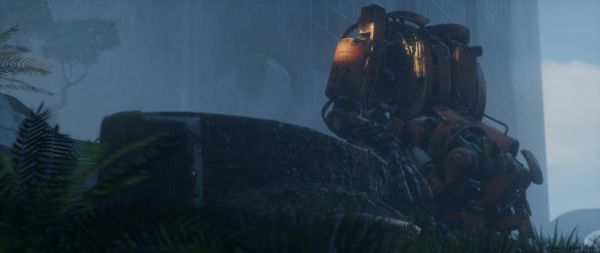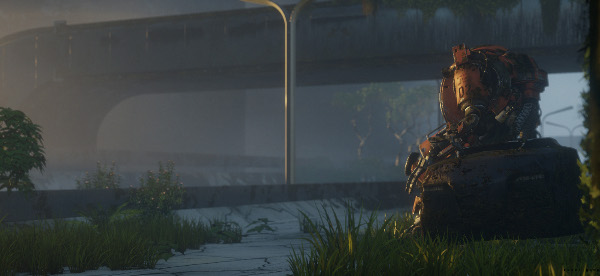
So yeah, that Reset trailer. Its sumptuous eye candy feast reduced the Internet to a slack-jawed chorus of “oooos” and “aaaaaahs.” Pitter-pattering raindrops, gently wavering foliage, and a blinding sun holding two giant scoops of intrigue turned the “single-player co-op” puzzler into the talk of the town. It had a lot of graphics, I suppose, is the short version of what I’m saying. And yet, all of that heart-wrenching, gob-smacking robot-on-a-car comtemplaction came from a two-person team. Two. So then, the obvious question: how? And, perhaps more importantly, why put so much work into visuals so early? I spoke with Theory Interactive’s Alpo Oksaharju about avoiding Dead Island trailer syndrome and why there’s more to Reset’s debut than meets the eye. For instance, that robot? Totally not a robot.
But first, how? Is it all smoke-and-mirrors? Can a game coming from such meager means really look like that? Theory Interactive is a witch coven, isn’t it? That has to be it. And yet, Oksaharju sounded pretty human, all things considered.
“After knowing what we wanted to accomplish, we sat down and asked a question,” he began. “It wasn’t ‘Can we do it’, it was ‘How can we do it?’ The key was knowing pretty specifically what features we needed and innovating new methods that allow us to produce as much stuff as possible with the least amount of effort. We threw out many industry standard workflows to suit specifically our needs. Our ridiculously tight resources made us think things from scratch. We questioned practically everything and derived workflows from that.”
“We’re working with standard i5 rigs with current-gen graphics cards. The game is being built on DX10 tech, so DX11 is not required – at least, not at this stage. Can’t really specualate on the final requirements, but our goal is to find a suitable set that doesn’t compromize the visual fidelity.”
Which sounds fairly reasonable, all things considered. Knowing that, I wasn’t entirely surprised to hear that Oksaharju and his partner in eyeball-caressing crime, Mikko Kallinen, met while working at benchmarking mastermind FutureMark. Granted, there’s always room to grow.

“Reset is a dream project for us, as we shared the same interest in what kind of games we want to make,” explained Oksaharju. ”We’re in this for the long haul, so getting more dedicated and talented individuals to join our team is pretty obvious. But we’ve [also] prepared to finish Reset with just the two of us since one of our prime directives is to stay independent.”
“Yes, it’s nearly, but not entirely impossible [to self-fund]. We can always make more holes in our belts, and hopefully when we release the game, there will be enough likeminded people that we can fund also our next project. We’ve been looking into Kickstarter and the like, but unfortunately we can’t apply for a Kickstarter project from Finland. There are some other EU based crowdfunding sites and we’re still going through them.”
So obviously, Oksaharju and Kallinen have big plans for the future, but what of the present? Reset’s proven it can do pretty, but how does it work? What is this vaunted “single-player co-op” we’ve been hearing so much about? While Oksaharju wasn’t ready to provide specifics, he did fill me in on the basics.
“You do one action and leap back in time to complement that action. There are a few games that I know of that have touched this subject before, The Misadventures of P.B.Winterbottom and Prometheus, a UDK mod. Our approach is somewhere in the same ballpark
perhaps, but it is not the same.”
Granted, it is a bit perplexing – especially seeing as Reset’s blog notes that the next big development milestone will focus on gameplay. In the land of development, that’s a bit, er, backward. There is, however, a method to Oksaharju and Kallinen’s apparent madness.
“We had to decide what parts we needed to do in what order, since we couldn’t parallellize much,” he said. “We have done game design enough to really stand behind it. Atmosphere and mood are a big part of what we want people to experience, so it was only natural to really make sure we can pull off what we wanted to achieve.”

Of course, moving too far in that direction can lead down a rather one-sided path, as evidenced by such prolific sadvertisements as Dead Island’s not entirely accurate debut. Reset’s obviously in-engine, but could a similar fate be in the cards if it fails to back up its claims? Oksaharju – in spite of gamers’ notorious cynicism about these sorts of things – isn’t losing any sleep.
“The trailer consists of all the major visual features we wanted to implement and it was a way to test them,” he explained. “At the same time we wanted to express the mood of the world and the story because it is a big part of the whole. We combined these two so in a way the trailer itself is a byproduct of the actual development. We would be poorly allocating resources if we just made a trailer for its own sake. We’re not worried about the Dead Island implication, but only time will tell if we can make your worries disappear.”
Ultimately, that is the (perhaps literally) million-dollar question. Will it all come together? Can it? For now, we can only watch and wait, seeing as Oksaharju and Kallinen certainly haven’t laid all their cards on the table. They did, however, leave me with this one last ace:
“The character is a human, but in an mech exosuit. This is the first time we’ve revealed this: the character’s name is Zero-Two.”
Hmmm. Could this mean asymmetrical sometimes-human, sometimes-exosuit single-player co-op? And where will time travel enter that picture? Anyone care to put on a long, wispy costume beard and spend some time with me in the vaguely suggestive speculation corner?
http://www.rockpapershotgun.com/2012/05/01/whats-in-a-trailer-reset-devs-explain-amazing-debut/

 @TheVoxelman on twitter
@TheVoxelman on twitter
















